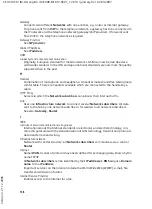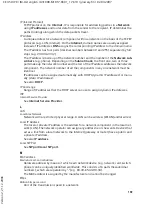
141
CE 450 IP R / IM-Ost english / A31008-M1817-R601_1-7619 / glossary.fm / 02.03.2007
Ve
rs
ion 2,
21
.12.
2006
Port
Data is exchanged between two applications in a
via a port.
Port Forwarding
The Internet gateway (e.g. your router) forwards data packets from the
that are
directed to a certain
to the port concerned. This allows servers in the
to offer
services on the Internet without you needing a public IP address.
Port number
Indicates a specific application of
. Depending on the setting in
, the port number is permanently assigned or else it is newly assigned with each
access.
The combination of
/
number uniquely identifies the recipient or sender
of a data packet within a network.
PPPoE
Point-to-Point Protocol over Ethernet
Protocol for connecting network subscribers within an
to the
via a modem.
PPTP
Point-to-Point Tunnelling Protocol
Protocol for setting up a virtual private network (Virtual Private Network VPN) via the
Internet. This allows the Point-to-Point protocol to tunnel through the IP network.
Private IP Address
.
Protocol
Describes the agreements for communicating within a
. It contains rules for
opening, administering and closing a connection, about data formats, time frames and
possible error handling.
Proxy/Proxy server
Computer program that controls the exchange of data between
and
computer networks. If the phone sends a query to the VoIP server, the proxy acts as a
server towards the phone and as a client towards the server. A proxy is addressed via
.
Public IP address
The public IP address is the address for a network component on the Internet. It is
assigned by the Internet service provider. Devices that act as a link from a local network
to the Internet (gateway or router) have a public and a local IP address.
See also:
Q
Quality of Service (QoS)
Describes the Quality of Service in communication networks. Differentiations are made
between various Quality of Service classes.
QoS influences the flow of data packets on the Internet e.g. by prioritising data packets,
bandwidth reservation and packet optimisation.
In VoIP networks, QoS influences the voice quality. If the whole infrastructure (router,
network server etc.) has QoS, the voice quality is better, i.e. fewer delays, less echoing,
less crackling.
















































